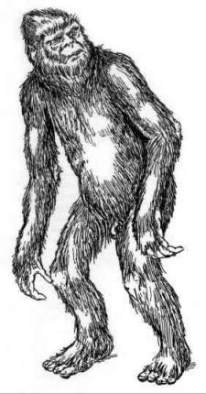Is George Schaller A Cryptozoologist?
Posted by: Loren Coleman on October 1st, 2008
In 2006, was one of Bigfoot’s newest spokespersons grossly misrepresented? Let’s revisit an issue I first reviewed two years ago to see if further clarification is available today.

How factual is the popular reporting on what famous people say about cryptozoological topics or animals they discover? How much can you rely on the background facts apparently noted in a newspaper in India or a foreword in a book to tell us what famed mountain gorilla researcher and promoter George B. Schaller (above) thinks about Bigfoot?

I guess it depends on what you feel is more closely reflecting George Schaller’s past statements and the actual realities.
In an October 1, 2006 biographical sketch of Schaller in The Hindu Times, there was published this examination:
Dr. Schaller is one of the few prominent scientists who strongly believe that reports of the sightings of the Bigfoot or the Yeti are worthy of further study. “There are so many human-like creatures in different places. But after all these years there is not a single bone, a single hair. There is no physical evidence other than tracks. There is one film, taken in 1960, and it has been played endlessly for years analysed, but they can’t say it is fake. A hard-eyed look is absolutely essential. The best thing to do would be to set up camera traps that automatically take pictures of the animals. If this is monitored for a year you may get nothing, but may end up with some interesting wildlife pictures,” he says with a hearty laugh.
The tough, unyielding scientist has a tremendous track record of rediscovering some rare species of animals that were thought to have been extinct. He was responsible for uncovering the Saola, one of the world’s rare mammals, in Laos; the Vietnamese Warty Pig; the Tibetan Red Deer and is one among the few who have seen the Snow Leopard in the wild.

Anyone that knows anything about Bigfoot, sees one glaring error in this short passage, on the Patterson-Gimlin footage’s date. I would suggest that a copyeditor at The Hindu Times is the source of this mistake.
We can easily check on what Schaller knows about Bigfoot. George B. Schaller makes a cameo appearance, so to speak, as the author of the foreword in Jeff Meldrum’s 2006 book, Sasquatch: Legend Meets Science. In his first pages there, Schaller writes:
The authenticity of films, especially the Patterson-Gimlin footage of 1967, has never been disproved. But there is still no proof. No bones, no skin, no conclusive DNA analysis from hairs. The question of existence remains open.
But surely the newspaper could fact check what animals Schaller has “re-discovered,” right?
Researching this a bit more, I found that it appears The Hindu Times merely extracted some of the biographical information straight from Wikipedia, where, in 2006, you would have discovered the following in George Schaller’s entry:
In 1994, Schaller and Dr. Alan Rabinowitz were the first scientists to uncover the rare saola in Laos. Later that year, Schaller rediscovered the Vietnamese warty pig, once thought extinct. In 1996, he located a herd of Tibetan red deer, also thought extinct.
Schaller is one of a few prominent scientists who argue that Bigfoot reports are worthy of further study. A 2003 Los Angeles Times story describes Schaller as a “Bigfoot skeptic”, but also reports his opinion that scientists don’t bother with researching the subject before they “write it off as a hoax or myth. I don’t think that’s fair.” In a 2003 Denver Post article Schaller said, “There have been so many sightings over the years … Even if you throw out 95 percent of them, there ought to be some explanation for the rest … I think a hard-eyed look is absolutely essential”. Schaller was perhaps proven correct, when Homo floresiensis was discovered, although the ‘little foot’ turned out to be a hobbit-sized hominid.
National Geographic has also produced some of the same material, once mentioning: “Schaller got Rabinowitz started with a Wildlife Conservation Society grant to study jaguars in Belize. Eventually the two worked together: In Laos, they discovered the rare saola, a forest-dwelling bovine.”

Unfortunately, Wikipedia, which uses, well, anyone to create entries on its site, may be a little off on some of its “facts.” How can Schaller and Rabinowitz be characterized as the “discoverers” of the saola?
In 1992, it was zoologists John MacKinnon and Vu Van Dung, plus a team of Vietnamese researchers, sponsored by the World Wildlife Fund, who went to explore a dense forested “lost world,” called the Vu Quang, in the sparsely populated mountains between Laos and Vietnam. Noticing skulls on posts near the village houses of hunters, MacKinnon asked about the trophies. The long sharp horns did not resemble any species he knew and it was MacKinnon and his Vietnamese associates who announced this was a new animal. The team that discovered and published in Nature in 1993, on the saola (Pseudoryx nghetinhensis) was, indeed, Vu Van Dung, Pham Mong Giao, Nguyen Ngoc Chinh, Do Tuoc, Peter Arctander and John MacKinnon. The zoologists MacKinnon and Vu Van Dung first discussed the saola in the 1992 Technical Report of MOF/WWF.

From National Geographic to Wikipedia, some revisions needed to happen, to give credit to the Vietnamese and MacKinnon for the saola.
But by 2008, the Wikipedia entry has been revised to just say this about the “Pseudoryx nghetinhensis founders”: “Saolas have only been known to zoologists since 1992, initially from unusual horns obtained in Vietnam.”
As far as the Vietnamese warty pig (Sus bucculentus), it was listed as extinct in 1996. In 1997 the species was reported to exist based on the discovery of a fresh skull. George Schaller has been credited with that, as has Laotian scientist Khamkhoun Khounboline. I’m not certain if one was more the discoverer than the other.
Regarding the Tibetan red deer (Cervus elaphus wallichi), there may be more of a dispute. Russian zoologist Vladimir Dinets (in 2006 a doctoral candidate at the University of Miami) claims to actually have been the first to have made the rediscovery of that species. He wrote in his well-publicized travel journal: “The Tibetan Red Deer had been believed to be extinct until I saw it in 1993; later G. Schaller discovered a second population in Kam.” It was not until 1996 that Schaller wrote that he located a herd of Tibetan red deer.
I suppose what Schaller says he senses is going on with Yeti and Bigfoot studies, in Meldrum’s foreword, may give us a hint about what Schaller’s thinking really is. But it is also clear that Schaller is a conservationist who is a political animal these days. Furthermore, his thoughts and discoveries have become extremely muddled in the media because of his celebrity. This is a state of being I would bet that even Schaller could not have seen occurring, as he appears to be a guy that likes to give credit where credit is due.
Where is this in 2008? Has Schaller further commented on Bigfoot or cryptozoology in the last two years? Considering most of his 2007 research was in the Pamirs, what are his thoughts on Almas?

Almas, as drawn by Harry Trumbore, from The Field Guide to Bigfoot and Other Mystery Primates.
About Loren Coleman
Loren Coleman is one of the world’s leading cryptozoologists, some say “the” leading living cryptozoologist. Certainly, he is acknowledged as the current living American researcher and writer who has most popularized cryptozoology in the late 20th and early 21st centuries.
Starting his fieldwork and investigations in 1960, after traveling and trekking extensively in pursuit of cryptozoological mysteries, Coleman began writing to share his experiences in 1969. An honorary member of Ivan T. Sanderson’s Society for the Investigation of the Unexplained in the 1970s, Coleman has been bestowed with similar honorary memberships of the North Idaho College Cryptozoology Club in 1983, and in subsequent years, that of the British Columbia Scientific Cryptozoology Club, CryptoSafari International, and other international organizations. He was also a Life Member and Benefactor of the International Society of Cryptozoology (now-defunct).
Loren Coleman’s daily blog, as a member of the Cryptomundo Team, served as an ongoing avenue of communication for the ever-growing body of cryptozoo news from 2005 through 2013. He returned as an infrequent contributor beginning Halloween week of 2015.
Coleman is the founder in 2003, and current director of the International Cryptozoology Museum in Portland, Maine.










Wow. Yeah, quite a bit of misrepresentation in there.
I wouldn’t allow it to cast too much of a smokescreen on what Schaller (who is quite clearly not a cryptozoologist) says about the sasquatch, though.
This (and I believe this really is something he said) is central: his opinion that scientists don’t bother with researching the subject before they “write it off as a hoax or myth. I don’t think that’s fair.”
And this does indeed come from the 2003 Denver Post article, which I’ve seen directly: “There have been so many sightings over the years … Even if you throw out 95 percent of them, there ought to be some explanation for the rest … I think a hard-eyed look is absolutely essential”.
Crypto or not, he feels the same way I do about this animal, and the way I think anyone should who has looked at – and evaluated objectively – as much evidence as either Schaller or I have.
It seems Schaller is a skeptic, in the truest sense of the word.
I met him years ago due to my essay on pandas and I remember asking him about bigfoot. He believed that there more species out there then we know.
Remember now this was in the 80s when I was in high school so alot of new species have been found since that time.
George Schaller will always have a place in my heart for his wonderful books about his field studies of big cats. Golden Shadows, Flying Hooves, The Deer and the Tiger, and especially Stones of Silence are among the best books I have ever read.
Schaller was the first person to get photos of snow leopards in the wild, and he was among the first to suggest that tigers in the wild are more social than was ever suspected.
He was awarded the Indianapolis Prize for 2008 in recognition of his lifelong dedication to conservation.
His open-mindedness about the possible existence of animals known only to folklore is one of the reasons for his discoveries. he’s absolutely right that an animal can’t be proven to exist without hard evidence.
If Bigfoot are out there, sooner or later irrefutable evidence will turn up.